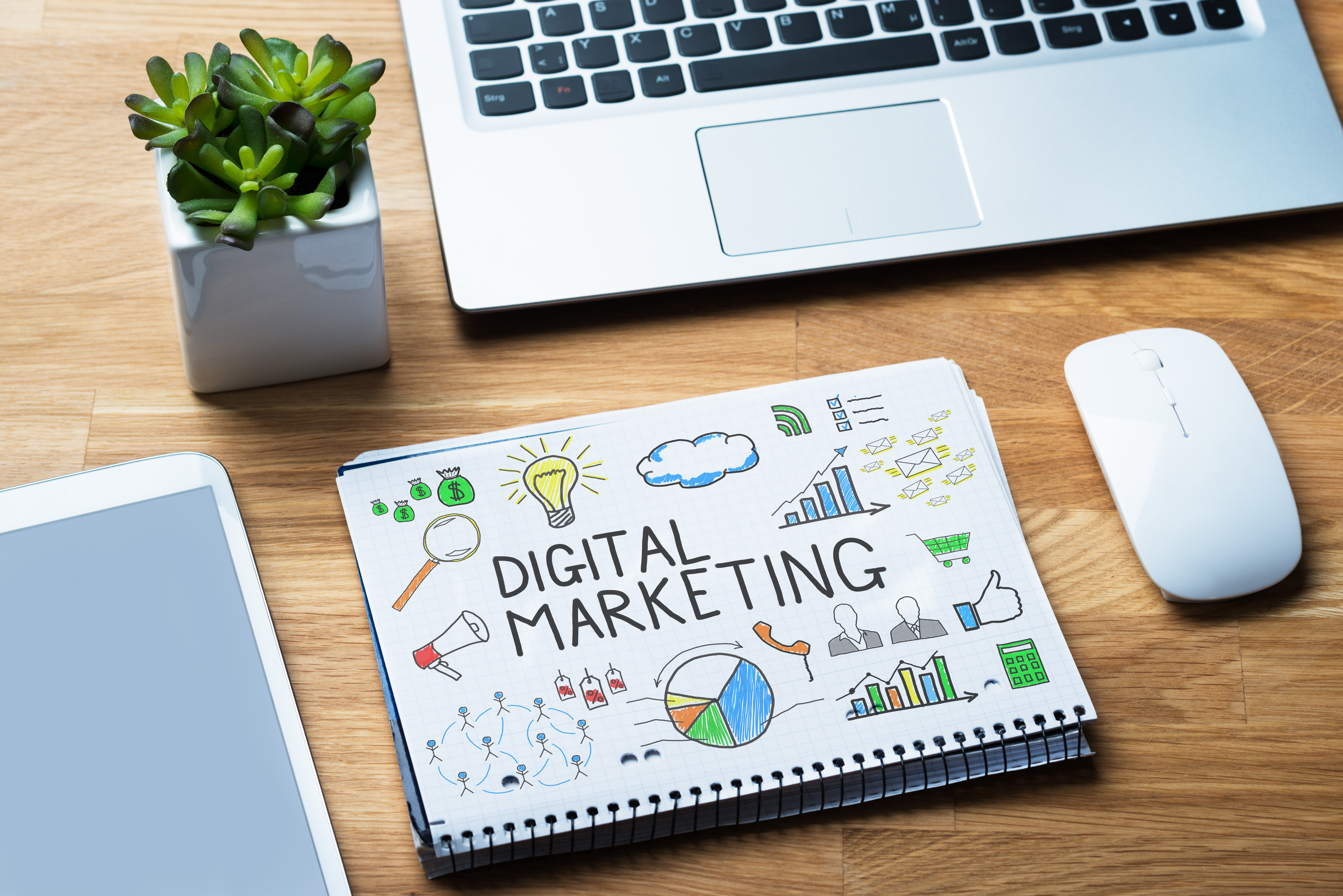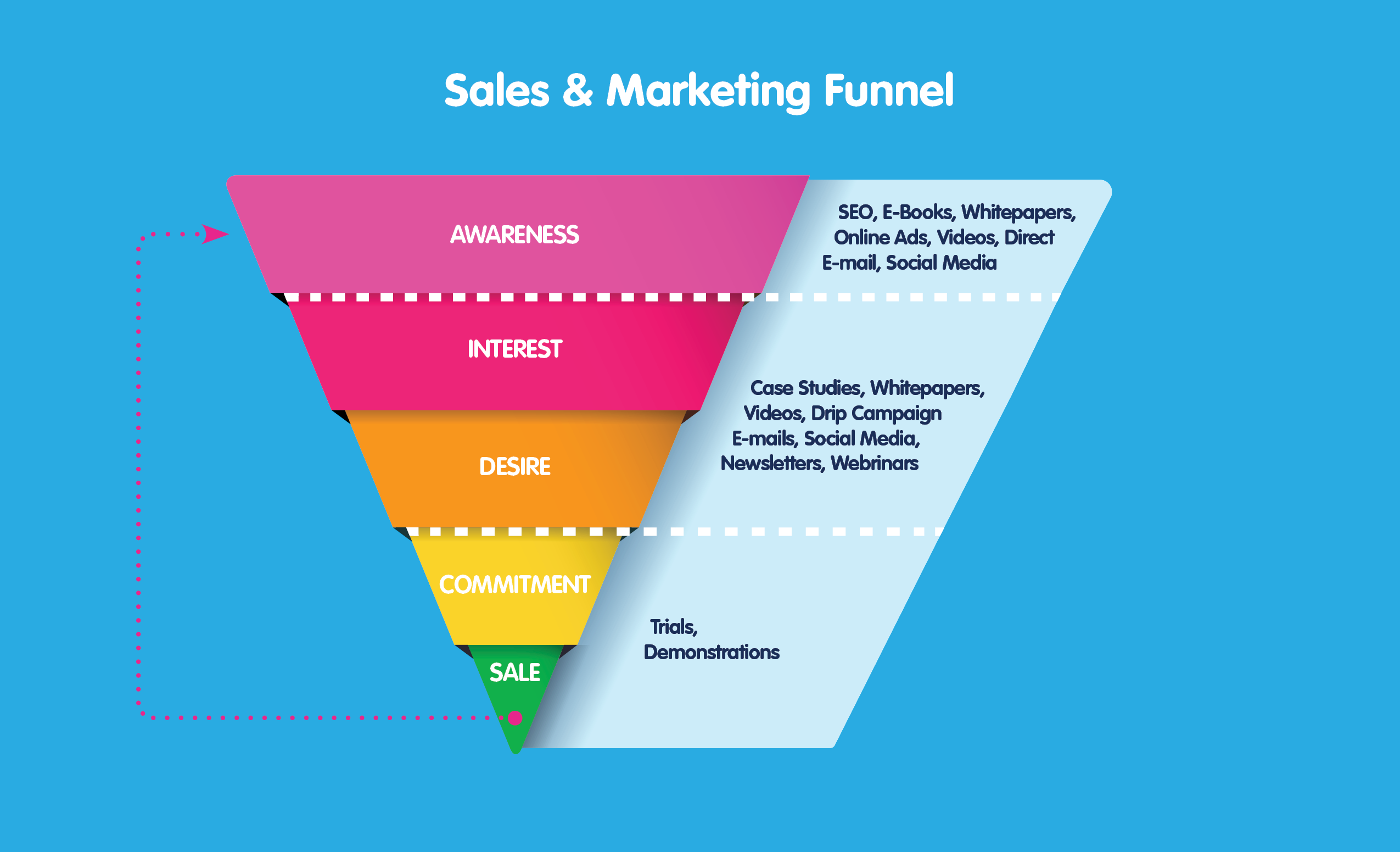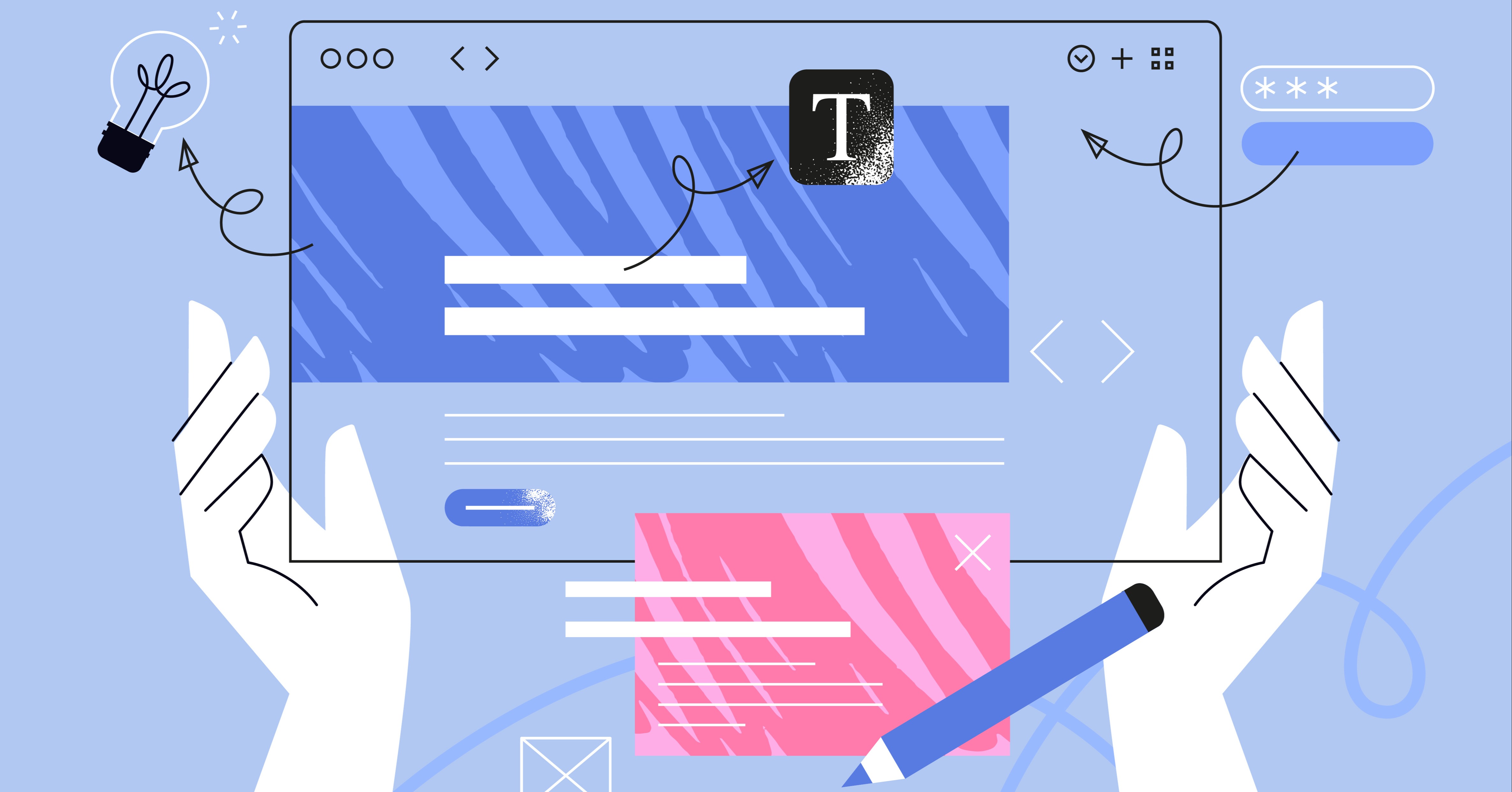
You’ve probably heard the term growth marketing a lot recently. Growth marketing is the fundamental process of boosting the performance and ROI of your digital transformation.
Growth marketing, also known as inbound marketing can assist traffic generation and lead marketing efforts within your business to bolster sales revenues. Through audience creation and demand generation strategies, businesses can insulate themselves from economic downturns and the rising cost of social media marketing.
But what you may not know, is that the keystone to any successful inbound marketing campaign, is a well-constructed marketing funnel, as they provide valuable insights into prospect and consumer behaviours.
Simply defined, a marketing funnel is the digital journey your prospects experience when interacting with your business, leading them from first interaction, to final purchase.
So why are they so important and how can your business benefit from having one
Marketing Funnels: A crash course
Marketing funnels are systems which engage your prospects across various touchpoints while tracking customer data. The data collected across multiple checkpoints and interactions with your prospects can help inform further processes and provide a feedback loop to refine your marketing funnel experience.
Designing, building and implementing a marketing funnel for your business could be the single most efficient way to increase revenue and ROI.
With a range of benefits for both you and your prospects, understanding the power of marketing funnels could be the difference between surviving and thriving in the digital age.
Marketing funnels can be broken down into three stages corresponding to the buyer’s journey: top of the funnel, middle of the funnel and bottom of the funnel.
Let’s explore the three stages of marketing funnels and how they’ll benefit your business.

Top of the Funnel: Awareness
The primary goal for the ‘top of the funnel’ is to generate and attract as much traffic as possible. The more traffic you attract into your funnel, the more prospects you’ll be able to convert into customers later on. This stage is called audience creation, and is responsible for building the pool of prospects which you’ll later convert into customers. A highly engaged audience has the potential to become the lifeblood of your business, maximising ROI and increasing revenue.
There are three big questions you must ask yourself before creating content for your marketing funnel:
-
Who is my ideal prospect?
-
What problems do they have?
-
Where do they look for solutions?
Asking these three questions will help inform what content you produce, which audience you produce it for and where they’ll find this information.
Next, you want to set about creating this valuable content for your audience. This stage can be assisted by an experienced content strategist to help design, create and implement various content forms for your prospects. Common content forms which are often found at the top of the funnel include eBooks, webinars, blog articles and social media posts.
Content pieces which are created with the sole purpose of attracting traffic into your funnel, are often called lead magnets. Lead magnets can be as complex or as simple as you like, but generally work best when kept simple and accessible, providing an immediate solution to a simple but pressing problem for your prospects.
Top of the funnel content is also responsible for establishing your brand voice and positioning your brand as an industry leader. Thought leadership and demand generation can play pivotal roles in determining the success of your marketing funnel, so are important concepts to understand. These principles are key in elevating the value of your funnel by contributing to one of the biggest benefits of a marketing funnel: repeat customers.
When designing top of the funnel content, be mindful that content is most effective when it seeks to serve and meets prospects where they are – wherever that may be. Once the prospect engages with your content and finds value in it, they can then be persuaded to enter your funnel. This may take the form of giving you their email address to access an eBook, join your Facebook Group, like your Facebook page, or sign up to your email newsletter. This stage is called the lead capture stage and often takes the form of a landing page with an effective Call To Action (CTA) promising valuable content on the other side.
Middle of the Funnel: Interest and Desire
Congratulations, you’ve made it! You’ve now successfully captured the contact information of your first prospect. They’ve consumed your brand’s content, found it valuable and have agreed to hand over their contact details in exchange for more valuable content.
The ‘middle of the funnel’ is responsible for nurturing your prospects with the valuable content you promised them when they entered your funnel. This nurturing stage can also include a further qualification task which seeks to understand your prospects’ goals. This can help inform which solution you target them with later on.
There are many ways to nurture prospects throughout their middle funnel journey. Some common methods include email marketing, social media marketing, live webinar events, advanced masterclass invitations, live Q&A videos or weekly newsletters.
Frequently engaging your prospects with valuable content is a great way to remain relevant to them. The sole purpose of this stage is to build desire within your prospects for your product or service by getting them interested in what you have to say.
As this is the consideration stage of the buyer’s journey, it’s important to breed trust and loyalty from all your brand communications. One key element which is often overlooked, is communication frequency. It’s important to not only identify the optimum number of times per week you interact with your prospects, but also what time of day. Although this remains important for email marketing (i.e. what time of day, or what day of the week you send your emails out across different time zones), it’s imperative to consider this when hosting live video events on social media. Again, it comes down to research, split testing and knowing your prospects.
Retargeting is another key component of the middle funnel experience. A little research into retargeting strategies (such as Facebook Pixel if using paid advertising) can go a long way to tracking what webpages your prospects visit most, which webpages convert the highest and which pages require further optimisation to decrease drop-off rates. This is statistically significant, as webpages typically only convert 2% of traffic on their first visit.
The middle of the funnel is all about moving prospects from awareness, to interest and desire. By providing valuable content which positions your brand as the solution to their problems, you can nurture and increase the prospect’s buying intent, transitioning them through to the next stage of the funnel.
This stage identifies potential buyers, separating or segmenting them from the portion of prospects who are never destined to become customers. This can be accelerated through higher-value content such as expert masterclasses.
Now is the time to pre-qualify your prospects: are they the right fit for your brand?
Bottom of the Funnel: Lead conversion (Commitment and sale)
By the time your prospects have reached the bottom of the funnel, they should be fully qualified and eager to become a customer or client. Their funnel journey so far should have qualified them as ideal prospects while nurturing their buying intent to near frenzied levels. It’s time to convert them into customers.
The number of prospects who make it to the bottom of the funnel will be significantly less than the number of prospects who entered funnel at the beginning. This is natural and to be expected. The good news, is that the prospects who do make it this far are now super eager to make a decision and become a customer. So, how do you close them?
This is the time to present your irresistible offer. Start by answering questions such as:
-
How much does your product or service cost?
-
What are your guarantees?
-
How is your product or service superior to other options your prospect has?
Now is also the time to unleash every piece of social proof you have. Testimonials from past clients, data insights into how you’ll achieve results for your customers or what ROI your product or service delivers for your customers.
The important thing to remember at this stage, is your prospects are human. They are intelligent. They may have a few lingering doubts. But most importantly, they will not take kindly to being disrespected by the hard sell. Instead, take an empathic approach by presenting your offer with a humble soft sell. After all, if you’re confident in your product or service, then it will be their loss if they decide not to take you up on your offer.
If your prospects are still on the fence, consider reducing the risk for them by offering risk-free guarantees, value stacking your offer or even giving them a trial discount. Generally speaking, it’s not good practice to reduce the cost of your product or service outright, as this may be perceived as an act of desperation.
Final considerations
One key point to note, is that when prospects consent to entering your marketing funnel by giving you their email address, you are entering into a contract of sorts, whereby they hand over their contact details with the understanding that you will, from here on in, continue to provide them with valuable content. It is also your legal (and moral) obligation to abide by the best data protection and anti-SPAM practices for your region. As it turns out, following anti-spam best practice will also increase your email deliverability , so it’s a win-win!
A common practice in funnel marketing is to offer a one-time limited discount on a lower-tier product or service to your prospects as a reward for signing up. This is often referred to as a trip wire offer and comes under the category of an upsell. Trip wire offers are generally low priced upsells offered to new subscribers as a limited offer, and may take the form of a premium webinar, a physical book, or an exclusive masterclass, among others.
While some prospects may value and appreciate your upsell offer, there’s also the chance it may backfire and be perceived as too ‘upfront’ by other prospects. Deciding whether to offer a low-price upsell in the form of a trip wire offer is up to you. But as with everything in marketing, it’s important to A/B split test and see if offering a trip wire offer increases or decreases business revenue.
It’s also important not to get bogged down in the details when starting out. Designing and building your marketing funnel should be an engaging and iterative process. If you’re not passionate about the content you’re publishing, how can you expect your prospects to be?
Be sure to track and analyse the unique metrics available to you through your funnel. These metrics afford key insights into your ideal prospects’ and customers’ browsing styles and buying habits. Key metrics to track include conversion rates, entry sources, time in stage, exits from stage, content engagement rates, opportunity arrival rates and close rates.
What next?
A marketing funnel is a great tool when combined with digital strategies that boost your performance. By designing, building and implementing an effective marketing funnel strategy, businesses can future-proof their sales revenue and increase ROI across their marketing efforts. Marketing funnels can be highly agile and provide a wealth of data insights which can be used to refine your offer and increase conversion rates.
We can help you create your digital strategy and thrive in your digital transformation. We work with you to design, construct and implement purpose-made content for every stage of the buyer’s journey, paired with digital enablement, deep-data and artificial intelligence.
Fileroom is a strategic digital agency, dedicated to promoting your business success. We can help your business by assisting with marketing funnels no matter which stage you’re currently at. We can help prepare your business for the future by attracting engaged prospects and delighting your clients while you focus on what you do best. Start a conversation today at Fileroom.



.png)






